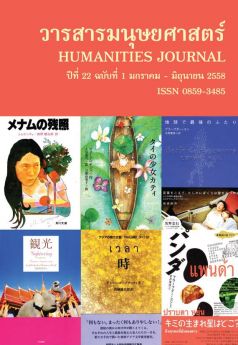การวิเคราะห์การเปลี่ยนแปลงของคำศัพท์ การประกอบอาหารไทยถิ่นเหนือของคนสามช่วงอายุ ในจังหวัดเชียงใหม่
Main Article Content
Abstract
งานวิจัยนี้มีวัตถุประสงค์เพื่อศึกษาการใช้คำและวิเคราะห์การเปลี่ยนแปลงลักษณะของคำและความหมายของคำศัพท์การประกอบอาหารไทยถิ่นเหนือ คำศัพท์ที่ใช้ศึกษาในงานวิจัยนี้ประกอบด้วยคาศัพท์ 48 คำ ซึ่งอ้างอิงจากงานวิจัยของโกสินทร์ ปัญญาอธิสิน (2552) โดยกลุ่มประชากรตัวอย่างที่ใช้ในงานวิจัย คือ ผู้บอกภาษาชาวไทยถิ่นเหนือจำนวน 30 คน แบ่งออกตามระดับช่วงอายุเป็น 3 กลุ่มคือ ช่วงอายุที่ 1 อายุ 55-65 ปี ช่วงอายุที่ 2 อายุ 35-45 ปี และช่วงอายุที่ 3 อายุ 15-25 ปี
ผลที่ได้จากการวิจัยสรุปได้ว่า อายุที่แตกต่างกันเป็นปัจจัยสำคัญที่ทาให้เกิดความแตกต่างในการใช้คำศัพท์การประกอบอาหารไทยถิ่นเหนือ โดยผู้บอกภาษาช่วงอายุที่ 1 พบว่ามีการใช้คำศัพท์การประกอบอาหารไทยถิ่นเหนือมากที่สุด ในขณะที่ช่วงอายุที่ 3 พบว่ามีการใช้คำศัพท์การประกอบอาหารไทยถิ่นเหนือน้อยที่สุด นอกจากนี้ยังพบว่า คำศัพท์การประกอบอาหารไทยถิ่นเหนือที่ยังคงใช้กันอยู่ทั้ง 3 ช่วงอายุ มีทั้งสิ้น 35 คำ คำศัพท์ที่กำลังจะสูญหายมีทั้งสิ้น 11 คำ และคำศัพท์ที่ไม่ปรากฏผู้ใช้แล้วมีทั้งสิ้น 2 คำ
ลักษณะการเปลี่ยนแปลงของคำศัพท์การประกอบอาหารไทยถิ่นเหนือ พบว่ามีการแปรทั้งเสียงพยัญชนะและสระในผู้บอกภาษาทุกช่วงอายุ โดยช่วงอายุที่ 3 มีการแปรมากที่สุด ส่วนการแปรด้านศัพท์ก็เช่นเดียวกัน คือ มีการใช้ศัพท์อื่นแทนคำศัพท์การประกอบอาหารเดิมในทั้ง 3 ช่วงอายุ นอกจากนี้ในการเปลี่ยนแปลงด้านความหมายของคำศัพท์การประกอบอาหารไทยถิ่นเหนือซึ่งเปรียบเทียบความหมายระหว่างผู้บอกภาษาทั้ง 3 ช่วงอายุโดยใช้ความหมายของผู้บอกภาษาช่วงอายุที่ 1 เป็นเกณฑ์ ซึ่งพบว่ามีการเปลี่ยนความหมายของคำศัพท์ 3 ลักษณะ คือ ความหมายกว้างออก ความหมายแคบเข้า และความหมายแบบผสม
An Analysis of Lexical Change in Northern Thai Cuisine Terms among Three Generations in Chiang Mai
Itsaree Sawangdee and Tasanalai Burapacheep
This research aimed to study the lexical usage and the lexical change of Northern Thai cuisine terms among three generations in Chiang Mai to identify some change in phonological and semantic aspects. The list of the Northern Thai cuisine terms used for the interview comprised 48 words complied by Panyaatisin (2009). The materials and data for this research work were collected from thirty informants living in Chiang Ma of three age categories, which were 55-65, 35-45 and 15-25 years of age.
The analysis reveals that the usage of Northern Thai cuisine terms were influenced by age. The oldest generation (55-65 years old) maintained the highest usage of traditional Northern Thai cuisine words, while the youngest group was found to use the fewest traditional terms. Furthermore, the study found that 35 cuisine terms were still used by all the three generations; 11 cuisine terms were expected to gradually fall out of use and two cuisine terms were now obsolete.
Regarding phonology, vowel and consonant variation were found in the usage of all three age groups, while the youngest generation (15-25 years old) exhibited these variations most prominently. In addition, it was found that the three groups borrowed cooking words from other dialects. Finally, as regards the semantic change of the terms under study, three categories of the change have been identified: the broadening of meaning, the narrowing of meaning and the combination of the two.


